For the first time, the group were meeting on a Wednesday to avoid clashing with the Quiz on Thursday. As Blue and Pink waited for food they decided to squeeze in a quick game of NMBR9 to celebrate our ninth birthday. This is a quick little tile-laying game that has almost zero setup time, so is very appealing as a filler in this sort of situation. The tiles are poly-ominos roughly shaped like the numbers zero to nine and there is a deck of cards featuring each number, zero to nine, twice. Players take the appropriate number from the box following a flip of a card, and add it to their personal play-space.
 |
| – Image by boardGOATS |
Tiles have to be placed in layers with tiles on higher layers being more valuable as the number on the tile is multiplied by the “storey” it is on. Tiles must be placed adjacent to another tile on the same layer and, when placing tiles on higher layers they must not be wholly over one other tile and must be completely supported (no bridging gaps or overhangs). This time, Pink managed to make it to four layers putting a seven on the top layer, his third “storey” to give twenty-one points. As a result he was sure he was going to win.
 |
| – Image by boardGOATS |
Pink had fewer tiles on the second and, particularly third levels, though, where Blue had concentrated her efforts. The effect was very similar, so much so that there was only one point in it, but much to his disappointment, even several recounts couldn’t put the deficit in Pink’s favour. He was cheered up by the imminent arrival of his pizza though and they were still eating when Green, Lilac, and then Teal turned up. Since Green and Lilac had missed last time, they introduced themselves to Teal and there was some general chit-chat as everyone else turned up.
 |
| – Image by boardGOATS |
Appropriately, as we were celebrating our ninth birthday, there were nine of us to play the traditional birthday “Feature Game“, Crappy Birthday, as we ate meeple decorated chocolate cupcakes. Crappy Birthday is a silly little party game but is a surprising amount of fun. As we explained the rules to Teal, we reminisced about last year, when we played it over two sessions (one wrapping our parcels and one giving them) in order to be able to play it online. Lime expressed his astonishment that it was a year ago, and everyone concurred that it didn’t feel like a year.
 |
| – Image by boardGOATS |
Crappy Birthday doesn’t sound like much: the game is played over one “year” and each player takes it in turns to have their birthday, with everyone else choosing a card from their hand as a “gift”. The birthday boy or girl then chooses their favourite and least favourite gifts and the givers of these each get a point. As such, those gifting are trying to avoid the mediocre , in a similar way to Dixit, but “not as good” as Purple opined. While most people around the table would agree that Dixit is the better game, this group tend to get more fun out of Crappy Birthday because of the really silly gifts on the cards.
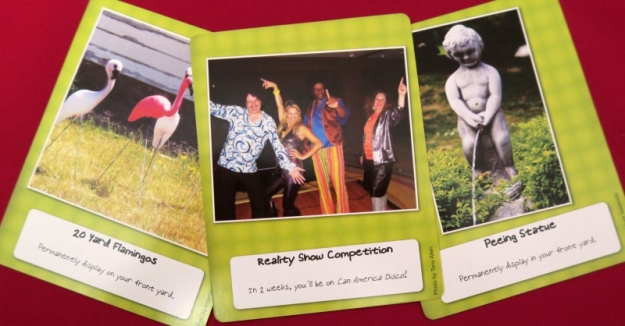 |
| – Image by boardGOATS |
The silliness of the gifts would get stale if we played the game more frequently, but we only play Crappy Birthday once a year and we usually only use around half the cards, so most cards only come out once every two years. It is a great way to find out about people though, so being new to the group, everyone thought Teal would be at quite a disadvantage. This year we found out that Pink was unimpressed by 100lb of raw fish, Lilac quite fancied a trying out a wingsuit and Blue would overcome the creepiness of 3am in the Paris catacombs as apparently they were hard to get to visit. Ivory, was torn between the opportunity to sing the National Anthem before a Major League Baseball game and getting his earlobes stretched, but went for the latter as his least favourite as it was more permanent.
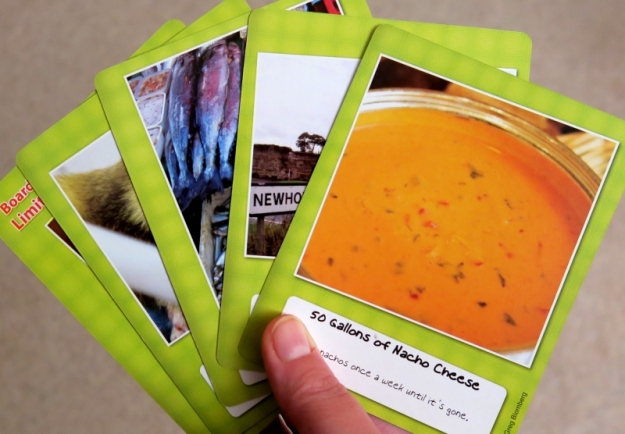 |
| – Image by boardGOATS |
We discovered that Teal likes to keep his feet on the ground, so he eschewed a flight in a fighter jet, but really liked the idea of a Viking helmet. It was about this point that we were joined by one of the former bar staff who stuck about to help Pink with his gift selection. It seemed she didn’t really help a lot though as he completely failed to get any of his gifts picked as best or worst.
 |
| – Image by boardGOATS |
From there, Purple nearly ended up instigating divorce proceedings when she received a set of camera scales from Black (a gift nobody else would have been prepared to give to anyone). Instead of fully justified revenge, however, Purple gave Black’s his favourite gift a campervan. Lime having just moved house eschewed recycled newspaper wallpaper, instead opting to decorate his new home with some modern art after some classes. DIY seemed to be in the air, as Green chose a house that needed renovation, though he volunteered Lilac to fix the roof.
 |
| – Image by boardGOATS |
As usual, Lime’s amazing gift-giving skills meant he did well, but this time he was beaten into third place by Purple and, remarkably, Teal who tied for first place, with four—it seems Teal knows us all surprisingly well after just a couple of weeks! As people counted their scores and decided what to play next, the group put together a special selection of gifts for Pine who was running late thanks to a group of over-enthusiastic cubs whom he had been showing round his work. This special selection was tailor-made for a vegan who doesn’t like horses.
 |
| – Image by boardGOATS |
From there, the group split into three, one led by Lilac who wanted to play Thurn und Taxis, one led by Ivory who wanted to play Key Flow and one led by Green to play with something short that Pine could join in with when he arrived. Thurn und Taxis is a slightly older, Spiel des Jahres winning game where players build postal routes connecting cities across Bavaria and surrounding regions. Routes are built city to city to city, so that each city is adjacent to the next city on the route and there is a road connecting these two cities.
 |
| – Image by boardGOATS |
Players are building routes by collecting cards and playing them in front of them. Every turn, the active player takes a city card from the face-up display (or blind from the top of the deck) and then plays a card for a city connected to either end of their existing route. The card played, must connect to their route, otherwise they have to discard their route and start again. Then they can score their route if they choose, but each route must consist of at least three cities and players may build only one route at a time.
 |
| – Image by boardGOATS |
If after adding to the route, the length of the route is at least three cities, the player may declare it finished and score it. Players start with a supply of twenty post offices in their colour, each of which is worth minus one at the end of the game. When they score a route, players place post offices in cities on the board, but they have a choice. Each city is in a region and each region has a colour, when a route is scored, the active player can either place one post office in one city in each of the region their route visits, or in all the cities on one of the regions their route goes to.
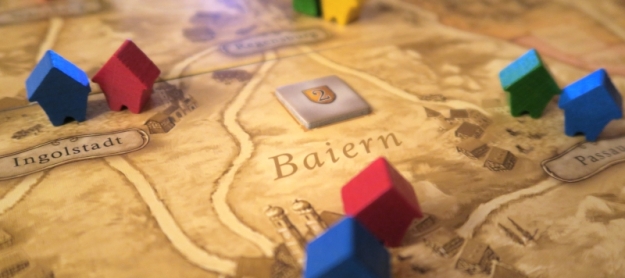 |
| – Image by boardGOATS |
When a route is scored, the active player can take a cart card. These give points, however, in the general case, the cart card must be one more than the previous one and the route must be longer than the cart number. Thus, if someone is scoring a six leg route, they can only take a level six card if their previous cart was a level five card. If they enlist the help of the Wainwright, however, if they have a level five card, they would be able to take a level six card with a route of only four legs. Once a route is scored, the city cards of that route are discarded, and the player begins a new route on their next turn.
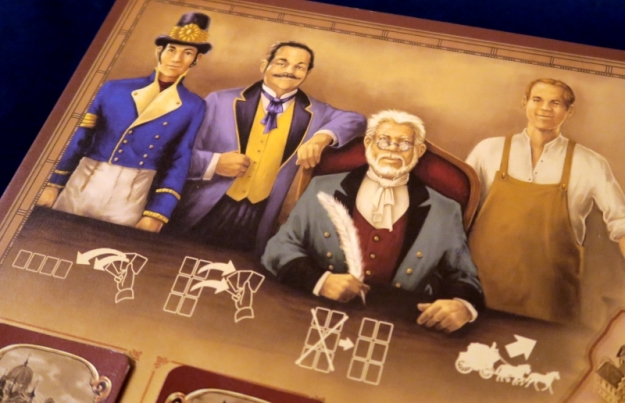 |
| – Image by boardGOATS |
The Wainwright is not the only special character in the game: the Postman, Bailiff and Coachman are all there to offer help, allowing players to take a second card, refresh the card market and play a second card respectively. Players can only enlist aid once per turn though, so they must choose who they call on carefully. When a player exhausts their supply of post offices or acquires a value seven carriage, the end of the game is triggered with players continuing the round—the player with the most points wins.
 |
| – Image by boardGOATS |
In addition to points for cart cards, there are also bonus points available for players to connect all the cities in a region or to have a post office in every outer region, as well as for players completing longer routes and for the player who triggers the end of the game. In general, bonuses score most for the first player to make the achievement with diminishing returns thereafter. This is therefore a consideration players must take into account, but the fact that players must add at least one city to their route each turn or lose the whole route is probably the most important aspect of planning in the game.
 |
| – Image by boardGOATS |
Although Thurn und Taxis is an older game, Purple had not played it before, and it took her a while to get her head round it. She got to grips with it eventually, however, it was later in the game and Black and Lilac had already got a head start. It was very close between them though with the scores neck-a-neck until the last. Lilac triggered the end of the game by taking a level seven cart card and with it took what turned out to be the decisive bonus point, pipping Black with twenty-seven points to his twenty-six.
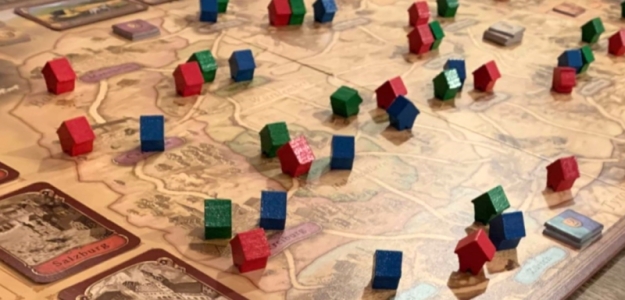 |
| – Image by Lilac |
On the next table, Teal had looked in the game bags and decided Azul was one he’d like to play. Green, Lime and Teal had just started without Pine when he inevitably arrived a couple of turns in. He politely eschewed their kind offers to start again, instead concentrating on his healthy supper of crisps and cake and choosing his gift. In Pine-like fashion, he chose to redefine the rules and decided his favourite gift was a hunting expedition as long as the subjects of the hunt were the people delivering the perkiness training in his other “choice” gift.
 |
| – Image by boardGOATS |
We have played a lot of Azul and its derivatives (Stained Glass of Sintra and Summer Pavilion) over the last three years, but the original is probably still the favourite across the group. It is really very simple, and despite being an abstract game, the pieces are really nice. On their turn, the active player either takes all the tiles of one colour from one of the “markets” putting the rest in the centre, or they take all the tiles of one colour from the central pool. They then add the tiles to one of the rows on their player board. The catch is that all the tiles placed in any row must be the same colour and if they over-flow, they score negatively. Additionally, each colour can only score in each row once.
 |
| – Image by boardGOATS |
Only complete rows are removed and scored, and then only at the end of the round (when all the tiles in the market and central pool have been taken). Thus if a player has a nearly complete row at the end of a round, they carry that through to the next round leaving them with less free space to work with. When a row is scored, one tile is moved to the player’s mosaic and scores for the number of tiles it forms a continuous row/column with. The game ends when one or more players complete two rows. This time it was a game of two halves, or rather two games. It had been a while since we played the original version (or any version for that matter), but it wasn’t long before Teal, Lime and Green were happily playing, filling their boards.
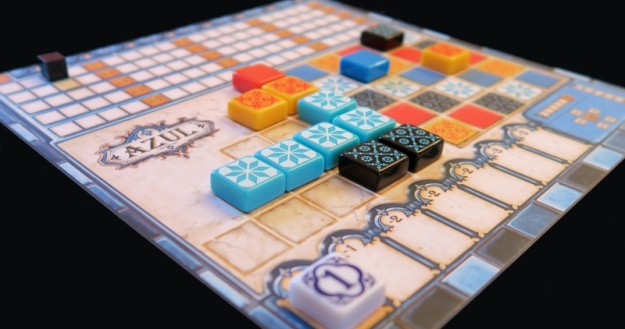 |
| – Image by boardGOATS |
Lime and Teal took an early lead and were soon well ahead of Green as he had concentrated on filling his grid from the bottom up, whereas they had been working from the top down. As the game progressed Green began to catch up. It was then that he realised that he’d forgotten what the game end trigger was. He’d thought it was when the markets could no-longer be refilled, but checked the rules to be sure. Only to find that two full completed rows had happened two turns earlier! The group decided to finish the round and make it the last. It was very close between Lime and Teal, with Lime just taking victory by three points. The other games were still going and it was not yet late, so the group decided to give it another go, and this time finish the game correctly.
 |
| – Image by boardGOATS |
In the second game, Green built his grid from the top down and the scores remained fairly similar, until around half way through when Teal began to pull away. It was at about this point that Green noticed that one row had tiles of a colour he’d already scored for that row. No-one was quite sure how it had happened, but the mutual decision was that he’d move these tiles down to the next row. That turn didn’t go quite as expected, but at least it wasn’t a complete disaster. The following round, he discovered he’d done the same thing again. This time he worked out what he’d done: he’d had failed to clear the remaining tiles when he moved one across to the pattern board. So, on the previous turn, instead of moving tiles, he should have removed them. It didn’t really matter though as Teal won by a landslide.
 |
| – Image by boardGOATS |
Meanwhile, Ivory, Blue and Pink had revised the rules, completed card set up for Key Flow, and had started playing. Key Flow is the card game of one of the group’s favourite games, Keyflower. In both games, players are building villages and activating the buildings in their villages by playing meeples (or rather Keyples) to generate resources and score points. The games have a lot in common including the artwork, the iconography and the fact both take place over four rounds or seasons. Fundamentally, the underlying game mechanism is different, however, with players acquiring tiles by auction in Keyflower and by card drafting in Key Flow.
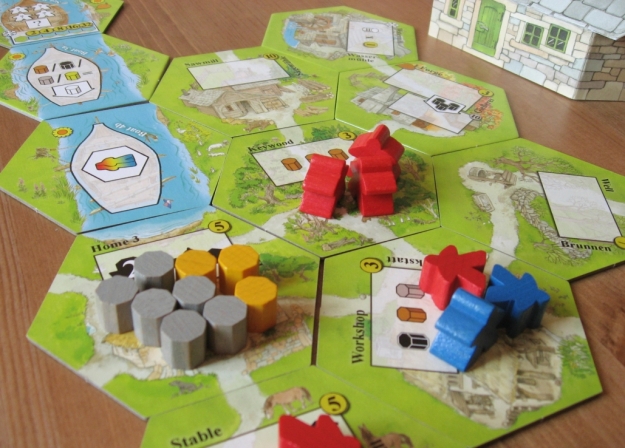 |
| – Image by boardGOATS |
Once the card decks have been sorted out, Key Flow is quite straightforward to play, though doing well is a different matter. Players who start with a hand of cards, choose one and pass the rest on. They then add their chosen card to their village. There are three types of card: Village cards, Riverside cards and “Keyple” cards. Village cards are buildings that can be activated by playing Keyples above them, while Riverside cards provide instant resources and skill tiles.
 |
| – Image by boardGOATS |
The cards have to be “connected” together and location can be important. Buildings for example are more productive if they have been upgraded, but upgrading needs resources and the resources need to be located on the building being upgraded. Similarly, in autumn there are some buildings which score points for resources they are holding. Therefore, it is helpful if the building producing the resources is near to the one being upgraded or used for scoring as moving resources can be expensive and sometimes difficult.
 |
| – Image by boardGOATS |
At the start of both Keyflower and Key Flow players get some winter tiles/cards which can act as objectives to guide players’ strategies. Whereas in Keyflower these are just added to the tile draw, in Key Flow, players get to keep one of their winter cards with the rest going into the draft. At the end of the game, at the end of winter, players score for any autumn cards, any buildings with upgrades as appropriate, any winter cards and finally one point for any otherwise unused gold.
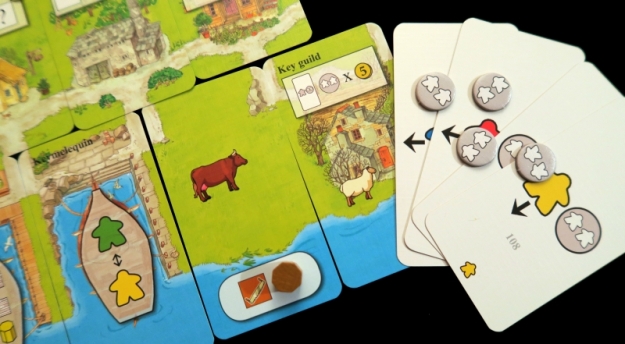 |
| – Image by boardGOATS |
One of the biggest differences between Key Flow and Keyflower is the way Keyples work. In Key Flow, they are cards and come in singletons and pairs. Each card has a small Keyple at the bottom of the card, and the number of Keyples needed to activate a building is one more than the number of small Keyples already there. So if there is one small Keeple already there, a pair would be needed to activate that building. Further, only one card is can be played each round, so if two small Keyples are already present, the Keyple card must be augmented with a Keyple token (obtained as a bonus with some cards or from some buildings).
 |
| – Image by boardGOATS |
Further, the Keyple cards also feature arrows which indicate where they can be played. Some can be played either in a neighbour’s village or the player’s own village. Other cards can only be played on one side or cannot be played in their own village. This is why three players is arguably the sweet-spot for Key Flow—with more players there is at least one village players cannot use, adding a level of randomness that it is difficult to deal with. With three however, everything in play is accessible, though perhaps at a cost.
 |
| – Image by boardGOATS |
It had been a while since Key Flow had been given an outing, so although game play is functionally straightforward, it took Blue, Ivory and Pink a while to remember the little features and how to make the game work for themselves. Pink started off early with an obvious strategy of generating stone, stone and even more stone from his Keystone Quarry. It was very clear, even to Pine who joined in to spectate about halfway through, that Pink had a winter card that would score for stone. And so it proved when he produced the Trader in the final round.
 |
| – Image by boardGOATS |
Things were less clear-cut for Blue and Ivory, however. Blue started by just playing the cards in her hand, which meant she ended up with a lot of cows (just because). In summer, Ivory picked up a boat that allowed him to convert sheep into pigs and pigs into sheep, which went nicely with his animal scoring winter cards. Blue, on the other hand, very out of practice with this sort of game, just played tactically, and played for points. Her Workshop went well with the Mercer’s Guild she had in her winter cards, but the Well and Goldsmith, both fully upgraded gave her thirty-five points alone.
 |
| – Image by boardGOATS |
Ivory had a bit of a nightmare and was unable to make the game work for him this time. This was made worse by a rule we only spotted towards the end which meant each Keyple card could only be used towards one goal and the fact he made a mess of things when he put a Riverside card in the middle of his village and had to make it work retrospectively. As he said sadly, although he had remembered how to play, he’d forgotten how to win. Pink, with his massive pile of stone thought he was in with a good chance, but they were actually only worth one and a half points each, so although he had a huge pile, it only gave him thirty-nine points and had taken a lot of work to get them.
 |
| – Image by boardGOATS |
Pink was a little bit stymied by the fact he was banking on also getting a a sheep scoring card in winter, but Ivory took it before it got round to him. Blue on the other hand had lucked out when she picked up a lot of Keyple scoring cards that nobody else seemed interested in giving her over a hundred points and a comfortable victory. With that, Ivory left, as did Lime and Teal, leaving Green, Pink, Blue and Pine waiting for the conclusion of Thurn und Taxis, and time to play a couple of rounds of Love Letter. In the end, it really was just a couple of rounds and ended with a round a piece for Green and Pink, as the pub was closing and it was time to leave.
 |
| – Image by boardGOATS |
Learning Outcome: While camera scales may seem like a good gift idea, in reality the giver will probably end up sleeping on the couch.